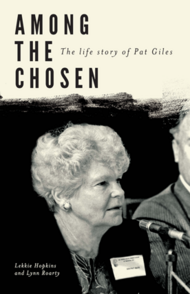INTERVIEW: Lekkie Hopkins and Lynn Roarty

ALP Senator and women’s campaigner Pat Giles’ favourite saying was ‘give a woman an inch and she’ll park a car in it’. It’s a saying her biographers Lekkie Hopkins and Lynn Roarty have taken to heart. In this interview they discuss their relationship with Pat and the writing of their new book Among the Chosen.
Lekkie: The story about the beginning of this project is a lovely one: Di Lesley, who is a counsellor at the Pat Giles Centre in Joondalup, was seated beside Pat at a Christmas dinner held by the Centre in 2004. She had not met Pat before and knew nothing about her life, so asked a few questions. Two hours later they were still talking.
Di said she came away from that event feeling inspired by Pat’s life, but really indignant that neither she nor anyone else she knew really understood what a significant contribution Pat has made to the lives of all women in Australia and indeed around the world.
It was Di’s idea that a biography be written, and she approached Kedy Kristal at the Pat Giles Centre to ask if there would be funding to do it. Kedy approached Sherry Saggers at the Centre for Social Research at ECU Joondalup, and together they got funding to start the project.
It wasn’t until Di and I began to interview Pat – we eventually generated twenty-six hours of tape-recorded interview from Pat alone – that I became aware of the extent of her contribution to the public arena, or of the intricacies of her private life.
What were some of Pat’s most significant achievements?
Lynn: For myself, I think one of her most significant achievements during her Senate years was her determination to establish the life experiences of women alongside those of men, to be considered as a matter of course and discussed openly in the public arena. In particular, her work towards ensuring women’s reproductive freedom, including the right to choose, is of lasting importance.
Pat’s involvement in the passage of the Sex Discrimination and Equal Opportunity legislation was significant, as was the work undertaken by the Status of Women Committee while she was Chair. Internationally, as well as her work with various UN women’s conferences, her appointment as Chair of the Global Commission on Women’s Health was both a well-deserved recognition of and a natural extension of the work she had been doing for so many years.
Lekkie: Pat was one of those remarkable women who came into middle age with a desire to be scooped up into feminist activism. She was at the first meetings of Women’s Liberation in Perth in the early 1970s, and was elected as first Convenor of Women’s Electoral Lobby (WEL) in Perth in 1973. She travelled to Mexico in 1975 to the first of the UN women’s meetings to celebrate the UN International Women’s Year in place of her mentor Irene Greenwood who was too frail to travel. A decade later, as a Senator Pat led the Australian delegation to the next large UN gathering at Nairobi, to celebrate the end of the UN Decade for Women.
Pat worked in the Australian trade union movement from 1974–1981. At the time of her appointment, the executive of the Trades and Labour Council (the peak trade union decision-making body in Western Australia) was exclusively male; and even at the level of daily union work, Giles’ appointment as an organiser in the Hospital Employees Industrial Union (HEIU) placed her amongst the first women ever to work within an industrial position in a Western Australian union. Within a year of her appointment to the HEIU she had invaded the all-male decision-making terrain to become the first woman to be elected to the Western Australian Trades and Labour Council executive.
How did you set a balance in the text between the private person and public figure of Pat Giles?
Lekkie: I think we all felt clear from the beginning that because Pat herself is such a private person, it was necessary to allow glimpses of her private life without making any of it gratuitously sensational. There was much trauma and pain and difficulty in Pat’s life, and although we wanted to acknowledge this, we didn’t want to over-emphasise it.
What qualities do you think drove Pat Giles to achieve what she did?
Lekkie: Optimism, stoicism, courage, practicality, determination to rid the world of injustice and discriminations of all kinds, belief in the capacity of the system (the political system, the parliament, the education system, the united nations systems) to be manipulated to work towards positive social change, belief in the basic decency of most human beings.
Lynn: And empathy with others – Pat seems to have always been able to put herself in the shoes of others and to see things from their point of view; she has a great capacity for compassion. These qualities manifested in very practical ways, enabling her to work with others to achieve positive outcomes. I would also add a great store of patience, and an ability to never lose sight of the big picture, qualities that allowed her to always celebrate the small victories.


